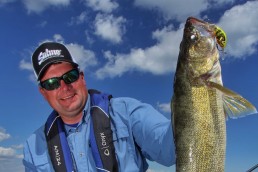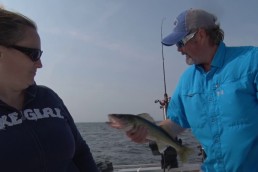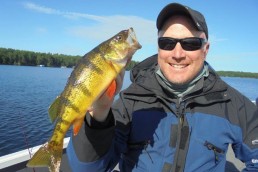Heavy Weights for Precisely Trolling Deep Structure
SHARE THIS POST
Historically, trolling structure in midsummer was “big-picture thinking” in that we chose long contours and consistent breaklines where we could put lures behind a boat and go. Because of the amount of line behind the boat, we then needed room to work for trolling to be effective. Large flats or a long, consistent contour line were perfect for trolling crankbaits. And big spots were perfect for trolling along with situations whenever the fish were scattered or suspended.
But over the past few years I’ve found myself trolling tighter locations that I’d never have dared before by using a bow-mount trolling motor in conjunction with heavy snap weights that I fish below a boat down into 40-foot depths. I don’t have a name for it—I don’t know what other people are calling it. But I can tell you that this trolling system is deadly effective and is changing the way I fish deep structure in August.
Trolling strategies in mid-to late summer continue to evolve due to advancements in GPS and mapping. Better contour maps and faster processers enable more precise boat control. I started running the Garmin GPS Map 7410 this season, which has an incredibly fast plotter. Regardless of unit you run, a nice feature for fishing a specific feature on structure is having a color option. This allows you to highlight a specific depth range. This, in conjunction with using the bow-mount trolling motor to pull the boat vs. pushing from the rear with a kicker motor, allows your boat to turn sharper. Essentially, all you have to do is “trace” the contour by watching your plotter. Pulling the boat vs. pushing it also allows you to turn sharply and follow extremely tight contours faster.
Regardless of boat control, if there’s a lot of line behind your boat—whether long-lining deep-diving crankbaits or using leadcore—the lures are way behind and don’t necessarily take the same path as your craft. A heavy snap-weight system allows you to put the lures right below your boat so that the lures stick right to the contour as you’re tracing it. This system does require enough weight, and often use 5- to 6-ounce snap weights. The whole method is fast in that, for example, I can get a couple of rods out in to 25 feet of water in a mere handful of seconds, whereas letting out leadcore takes several.
On most inland water where there aren’t any zebra mussels, the lead between the lure and the snap weight only needs to be a rod’s length, which speeds up the setup time even more dramatically. When you can get away with the shorter lead, a simple, fixed option like a three-way swivel can be used in conjunction with a large crankbait snap where one end of the snap is attached to the weight and the other is attached to the three-way swivel. When the water is extremely clear, it seems like the fish dictate that you have a longer lead and that monofilament is necessary. Mille Lacs is an interesting case in that I used to run a braided leader behind my leadcore. But now I catch more fish there by running a longer mono leader.
The entire snap-weight structure program is simple: Drop down until you hit the bottom and crank up line until you can feel the crankbait vibrating. If you’re marking fish higher off the bottom, simply crank up the weight higher off the bottom. The lure essentially runs about the same depth as the snap weight when using the shorter lead.
Are you enjoying this post?
You can be among the first to get the latest info on where to go, what to use and how to use it!
The advantage of this system is that you can fish through locations fast and turn around faster after you find fish. We often find ourselves just doing a figure eight over a school where we can go over these fish and immediately turn back around to go through them again. Irregular contours can be followed extremely effectively, and because the setup time is so fast, anglers can troll much smaller and in tighter locations.
A traditional trolling speed might range around 2 mph. But what I find with the snap weights is that a slightly slower trolling speed can be effective, where I’ll move at about 1.5 mph. What happens is that the lures speed up and then stall with every turn.
Because you don’t have a prop turning at the back of the boat, and because of the sharp angle the line takes below the boat, we can then run rods off the bow and out the back of the boat when we run four lines—much like how you would run bottom bouncers and spinners when trolling with the bow mount.
If you do have to troll against the waves or across the waves where the bow mount struggles to hold, you can also use the kicker motor for forward propulsion and simply steer with the bow mount. However, I often find that under most conditions I can just pull the boat for a long amount of time at 1.5 mph with most 24- and 36-volt trolling motors.
This system has been productive in deep rock structure where the fish will hold on tight to one specific ledge or depth range. Following the sharp edges of reefs or deep primary points is simple and fast. Equally effective on both reservoirs and natural lakes, the simplicity and efficiency of this trolling method can enable you to catch more walleyes this season.
MWO
SHARE THIS POST
Did you enjoy this post?
You can be among the first to get the latest info on where to go, what to use and how to use it!
Jason Mitchell
Jason Mitchell was a top walleye guide on Devils Lake, N.D. for nearly 20 years. Today, Mitchell produces the Jason Mitchell Outdoors TV program. Visit jasonmitchelloutdoors.com for more.



